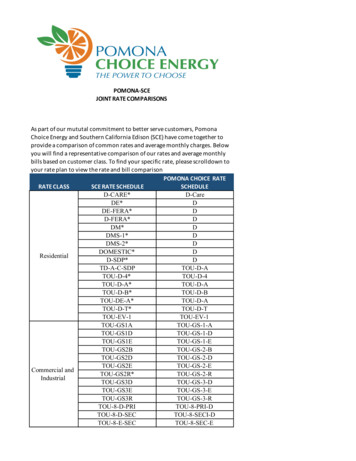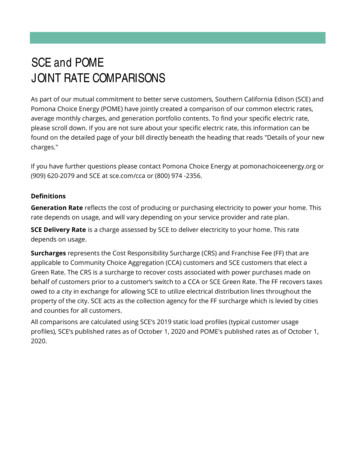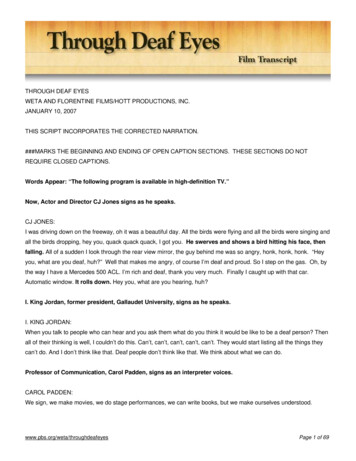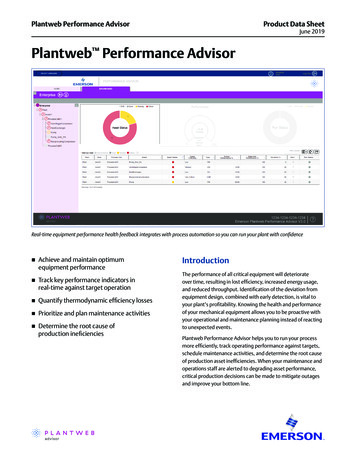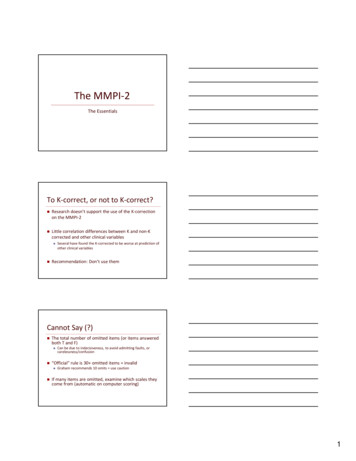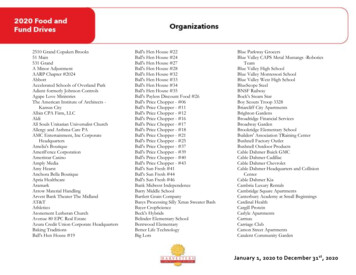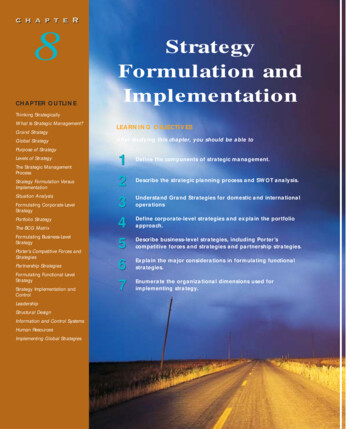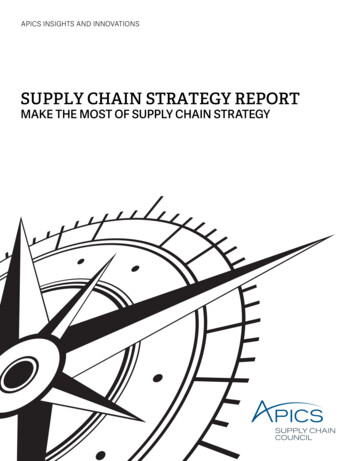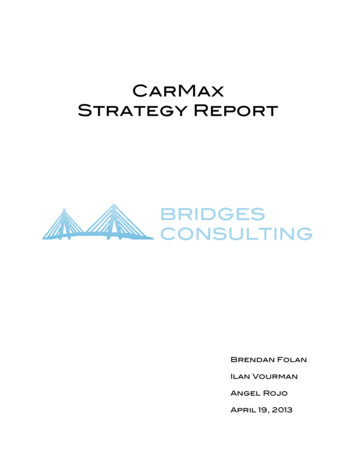
Transcription
CarMaxStrategy ReportBrendan FolanIlan VourmanAngel RojoApril 19, 2013
ContentsExecutive Summary . 3Company Background . 4Financial Analysis . 7Profitability & Shareholder Returns . 7Liquidity & Solvency. 8DuPont Analysis. 9Stock Performance . 10Competitive Analysis (Five Forces Framework) . 13Market Definition . 13Internal Rivalry . 14Entry & Exit . 14Substitutes & Complements . 16Supplier Power . 16Buyer Power . 17SWOT Analysis . 19Strengths . 19Weaknesses . 22Opportunities . 22Threats . 23Strategic Recommendations . 252
Executive SummaryCarMax (NYSE: KMX) is the largest used car retailer in the United States. Founded in 1993 as asubsidiary of electronics retailer Circuit City, the company differentiates itself from competitors inthe used car space with its wide selection of high quality vehicles and a customer-oriented salesprocess that includes “no-haggle” pricing. CarMax has had its own publicly traded stock since 1997and has been a standalone company since October 2002. Although CarMax specializes in latemodel used vehicles (vehicles 0 to 6 years old, typically priced between 12,000 and 32,000,constituted 90% of CarMax’s used vehicle sales in fiscal 2012), the company also sells older usedvehicles at retail, lower-quality used vehicles at wholesale, and three makes of new vehicles at four ofthe company’s approximately 116 locations. In addition to new and used vehicles, CarMax alsoprovides a variety of complementary products and services, including the CarMax Auto Financeoperation, the purchase of vehicles from consumers, and vehicle repairs.Having opened its first store in 1993, CarMax has grown rapidly to over 116 superstores.The company anticipates opening 10 new locations in fiscal 2013, as well as 10-15 superstores eachyear from fiscal 2014-2016. Since fiscal 2007, the company has grown revenues by roughly 34%,and net income has risen by 114% in the same period. In fiscal 2012, net earnings rose 10% to 413.8 million. CarMax continues to grow rapidly, as the company had stores in markets coveringonly about 50% of the US population in February 2012.CarMax’s rapid expansion and innovative business model have been the key elements of thecompany’s success. The company was the first to pioneer “no-haggle” prices in a used car salesenvironment, and it was among the earliest to rely heavily on Internet traffic to its website for sellingcars. In recent years, CarMax has continued this tradition of innovation with its mobile application,which is essentially its website content optimized for the smartphone platform.3
Company BackgroundThe CarMax story began in 1990 when top executives Rick Sharp and Austin Ligon of now-defunctretail electronics chain Circuit City sought to find new growth opportunities in retail. The used carmarket looked promising, as there were no retailers with national scale in that segment. When theCircuit City board of directors approved 50 million in funding for the new venture in December1991, the CarMax idea started to become a reality. Richard Sharp became the chairman and CEO.After extensive testing with focus groups in 1992, the CarMax founders realized howdissatisfying the traditional car-buying experience was for a typical consumer. Circuit City VP ofCorporate Planning Austin Ligon decided to reinvent the car-buying process from the ground up.Even from the beginning, CarMax was destined to be a revolutionary car-buying experience: free ofhaggling, transparent, convenient. In September 1993, the CarMax idea became a reality with theopening of the first location in Richmond, Virginia. The company initially took a conservativeapproach to growth in 1994 and 1995, as it opened only three new locations during those years.1996 proved to be an important year for CarMax. Management launched an aggressive fiveyear expansion plan with the aim of having 80-90 retail locations by 2001. To achieve this goal, thecompany would have to grow rapidly, opening 15-20 new superstores each year. CarMax’s website,carmax.com, made its debut in October 1996. Like the company’s retail stores, the CarMax websiteoffered a convenient and transparent experience to customers: The website features a completesearchable vehicle database with information about price, make, model, mileage, and features.AutoNation, the largest auto retailer in the US, entered the used car superstore market in 1996.In 1997 CarMax had its initial public offering, even though the company was still asubsidiary of Circuit City at the time. Circuit City sold a stake of approximately 25% in the company.The 413 million net proceeds of the IPO repaid growth-incurred debt to the corporate parent. In1998 CarMax moved into the new car retailing space with the purchase of a Toyota dealership inMaryland and a Wisconsin auto mall selling several makes of vehicles. Total sales for fiscal 1999surpassed 1 billion; however, CarMax reneged on its earlier growth plans, deciding instead to focuson store-level profitability and the operational side of the business. In response to mounting losses,competitor AutoNation exited the used car retail market in 1999.4
CarMax earned its first annual profit in fiscal 2000; shortly thereafter in calendar 2001, thecompany announced its plan to resume rapid growth (15% to 20%) of its store base. The companyannounced its goal of doubling sales to nearly 5 billion in revenue within five years. In mid-2001,Circuit City sold a further 10% of CarMax stock; the parent’s ownership now stood at 65%. CircuitCity completely spun off its CarMax business in October 2002. With the separation of Circuit Cityand CarMax came the promotion of President Austin Ligon to CEO for the auto retailer, whileRichard Sharp retained the title of chairman.2003 saw the opening of five used car superstores but the sale of four new car dealerships asCarMax refocused on its bread-and-butter used car business. 10 years after its founding, thecompany sold its one millionth used car. CarMax became a Fortune 500 company in 2004, startingat #435. CarMax reached its sales goal of 5 billion in fiscal 2005, one year ahead of its 2006 goalset in 2001. Having reached this high goal a year ahead of schedule, CarMax soon after announcedanother ambitious sales goal of 10 billion to 12 billion by fiscal 2010. In 2006, CEO Austin Ligonretired; Tom Folliard, previously EVP of Store Operations, succeeded him as the company’s chiefexecutive. In January 2007, the company reached another milestone: two million used vehicles sold.Because of poor prevailing macroeconomic conditions and a particularly bleak outlook forauto sales, CarMax suspended its store growth and cancelled the opening of new locations inDecember 2008, with the exception of the 100th store, which was already under construction at thetime the decision was announced. This location opened in 2009. In 2010 CarMax reached themilestone of three million used vehicles sold but missed its sales target of 10 billion. Theexpansion plan resumed in 2010, with a goal of opening three stores in fiscal 2011, between threeand five in fiscal 2012, and between five and ten in fiscal 2013. Although the company was growingagain, its expansion plan for 2010-2012 paled in comparison to the ambitious growth seen in theearly 2000s. Fiscal 2012 sales finally met the 5-year target set in 2005 of 10 billion. The pace ofexpansion picked up for fiscal 2013, coming in at the high end (10) of the previous target of five toten new locations. As for the future, the company plans to open between ten and 15 stores eachfiscal year from 2014 through 2016.5
CarMax Used Car Stores:Opened During Fiscal Year and Total1201008060402002007200820092010Used car stores opened during fiscal year2011Used car stores at end of fiscal yearData Sources: 2012 and 2009 CarMax 10-K’s62012
Financial AnalysisProfitability & Shareholder ReturnsCarMax revenues and profits have been rising steadily over the past several years. Net salesand operating revenues increased 10% to 10.96 billion from FY 2012, while net earnings increased5% to 434.3 million, or 1.87 per share. Total gross profit increased 13.4% to 1.46 billion from 1.38 billion FY 2012 as well. In the most recent quarter for which data are available, Q4 2013(ended February 28, 2013), sales rose 14% to 2.8 billion, above analyst consensus estimates of 2.7billion. Net income for the quarter was 107.2 million, or 0.46 per share, in line with analystexpectations.CarMax has also boosted its top line by both expanding sales at existing locations andexpanding aggressively with new store locations. Same-store used vehicle unit sales grew 5% infiscal 2013; same-store used vehicle dollar sales increased 7% for the fiscal year. After temporarilyceasing store growth due to weak economic conditions in 2008, CarMax resumed its expansion inFY 2011 by opening three superstores, and five followed in 2012. CarMax planned to open 10superstores in FY 2013, and between 10 and 15 stores for the following three years. As ofNovember 30, 2012, CarMax had 110 used car superstars in markets that comprised approximately53% of the U.S. population.Comparable Store Used Vehicle Sales ChangesThree Months Ended February 28 or 29 Three Months Ended February 28 or 292013201220132012Units6%4%5%1%Dollars10 %7%7%7%Data Source: CarMax News Release 4/10/131CarMax generates revenue in three principal ways. Firstly, CarMax’s core business is the saleof used vehicles, typically between 0-6 years old. For the last fiscal year for which full data areavailable (FY 2012), revenues in this area increased 9% to 7.83 billion from 7.21 billion in FY2011. While the average used vehicle selling price has increased 5% in this period, this rise is mainlyhttp://phx.corporate-ir.net/phoenix.zhtml?c 232927&p irolnewsArticle&ID 1805179&highlight 17
a reflection of the increased acquisition costs due to increased wholesale values. Total used vehicleunit sales increased 3% from FY 2011, reflecting both a 1% increase in comparable store used unitsales and sales from the newest locations, which have not yet been included in the comparable storebase. This 1% increase reveals a dramatic drop from the 10% comparable store sales witnessed in2011, which has mainly been attributed to the continuation of weak economic conditions and lowconsumer confidence.Secondly, CarMax generates profits through its wholesale operations, which includes theselling of cars that do not make the cut for its used vehicle sales. Total wholesale vehicle revenuesincreased 32% in FY 2012 to 1.72 billion. This large increase in revenues can be explained by a20% increase in wholesale vehicle sales, increased appraisal traffic, and a 10% increase in of theaverage wholesale selling price seen across the industry.Thirdly, CarMax’s auto financing division (CAF) experienced a 19% increase in income inFY 2012 to 262.2 million. Interest and fee income grew by 29.6 million headed by the growth inaverage managed receivables, while at the same time interest expense declined 27.7 million due tothe fact that a larger percentage of their managed portfolio was funded with lower-costsecuritizations. In addition, the provision for loan losses increased to 36.4 million from 27.1million in FY2011, reflecting both the absolute increase in managed receivables as well as theorigination and retention of higher-risk loans.CarMax’s return on equity of 14.91% is slightly above the industry average of 14.5%. Returnon equity measures how effectively an investor’s money is being utilized, and CarMax managementappears to be doing an effective job managing paid-in capital.Liquidity & SolvencyIn addition to CarMax’s relatively high profit margins, the company also has an impressivecurrent ratio of 3.62. The higher the current ratio, the better a company is able to cover its liabilitiesfor the upcoming year with its liquid assets, with a solid benchmark current ratio considered about 2.A current ratio of 1 or above is typically considered satisfactory. CarMax’s debt-to-equity ratio of1.9 is below that of industry peers Sonic Automotive, AutoNation, and Penske Auto Group, which8
have ratios of 2.8, 2.7, and 2.3, respectively. CarMax could take on additional debt to boost profitsand finance its continued expansion. This relatively low debt-to-equity ratio is particularly unusualgiven the company’s rapid growth. CarMax has a cash flow of 567.2 million, which is the cashgenerated by its sales and services.Many analysts are concerned about CarMax’s increase in expenditures, with the companyspending 819.3 million in cash while only booking a net income of 422.1 million, meaning thatfree cash flow is much less than net revenue, which ideally should be the opposite. In addition,19.4% of CarMax’s operating cash flow has been labeled as coming from “questionable” sourcessuch as changes in taxes payable, tax benefits from stock options, and asset sales, with stock basedcompensation and associated tax benefits accounting for the biggest boost. Most analysts do notlike this number to exceed 10%. However, the largest drag on free cash flow was capitalexpenditures (44.3%), which is in line with CarMax’s plans to expand its superstores.DuPont AnalysisCarMax (KMX)AutoNation(AN)Copart (CPRT)Penske (PAG)Group 1 (GPI)Sonic (SAH)Asbury (ABG)Lithia OEData Source: Yahoo FinanceIn the automotive retailing business, CarMax leads its peers in net profit margin. Assetturnover is lower than for competitors, as one would expect for a company whose primary businessis selling used, rather than new cars. AutoNation and Penske Automotive Group in particular havenumerous luxury brands in their portfolio of dealerships, so the significantly higher retail sales priceof new luxury vehicles compared to used non-luxury cars explains these companies’ greater assetturnover. As for leverage, CarMax appears to be on the lower end of the spectrum, which indicates9
the company might want to issue some new debt to finance its aggressive expansion plans.CarMax’s ROE is broadly in line with industry norms, thanks to the company’s stellar profit margin,though niche players Asbury, which operates primarily in the South, and Lithia, which focuses onmore rural markets, have markedly higher return on equity than CarMax.Stock PerformanceCarMax (NYSE: KMX) has performed relatively well compared to its peers, although itshould be noted that CarMax is in many ways a class of its own. Many of CarMax’s “competitors,”or the companies to which it is often compared, include large retail dealer chains and automotiveparts/services companies, although they do not truly compete directly with CarMax for business.The current price of a stock of CarMax is 42.09 (as of 4/15/13). The stock has seen anupward climb since January of 2012, but it is currently trading within a narrow range. Analystsgenerally have a positive outlook for CarMax, as they forecast future revenue growth ofapproximately 10% for FY 2014 spurred by a combination of comparable store sales growth, newstore additions and increased credit availability. However, operating margins will decrease slightly asselling, general & administrative costs will increase with the opening and operation of new stores.Although CarMax has an industry-leading market cap of 9.54B, the company still accountsfor only 2% of all total late model units sold. It also has the highest 5-year PEG ratio (1.73) of itspeer group, meaning that one is not paying a premium for the stock price based on future expectedgrowth. Although PEG is not always a valid indicator based on the type of company, due toCarMax’s rapid growth and plans for expansion, PEG should be an important metric to consider.In addition, it has a P/E ratio of just over 22, which is slightly higher than the sector average of21.05. While CarMax may trade at a premium to other automotive retailers, most analysts feel sucha price is warranted for better-than-peers net margins.10
Source: Yahoo Finance (4/15/13). Industry is auto dealers.Source: Yahoo Finance (4/15/13)11
CompanyProfitMarginCurrentRatioReturn onEquityDebt toEquityCash FlowfromOperationsCarMaxAutoNation CoPartPenskeGroup .77%2.42%3.62times1.05 71%31.64%15.79%12.02%1.90times2.75 9times2.6times1.29times19.97%2.06times 567.72M 316.6 M 192.41M 323.4M 75.32M 21.64M 234.9M 212.48MSource: %
Competitive AnalysisEntryand rPowerHighSubstitutesandComplementsModerateMarket DefinitionThe automotive retail market in the US can be broken down into two primary submarkets ofnew and used retailing, as well as complementary services such as financing and maintenance/repairs,which are almost always offered at car dealerships. Consumers often elect to return to the originaldealership where they purchased a vehicle for post-sale services such as maintenance. Geographicpositioning is an equally important factor on two levels: Automotive retailers are either independentor part of a national (or perhaps regional) group, and they can choose to locate in majormetropolitan areas, rural areas, or somewhere in between. For the purposes of this analysis, themarket is considered to be national automotive retailers with operations concentrated in mediumand large metropolitan areas. CarMax is a national full-service automotive retailer that sells primarilyused cars2, primarily in mid-sized markets, which the company defines as those with a TV viewingpopulation between 600,000 and 2,500,000 people.“During fiscal 2012, we sold 408,080 used cars, representing 98% of the total 415,759 vehicles wesold at retail” 2012 CarMax 10-K. Used vehicle sales at retail also accounted for approximately97.5% of revenues from car sales in fiscal 2012.213
Internal Rivalry – LowAlthough there are few companies with national scale in the industry – only AutoNation,CarMax, Group 1 Automotive, Penske Automotive Group, and Sonic Automotive come to mind –the industry is highly fragmented because most dealerships are not part of a much larger group.Even franchises belonging to the same company and selling the same make may compete with eachother because of the commission-based compensation structure common to most automotiveretailers. There were approximately 17,000 new car dealerships3 in the US in 2012, and estimates forthe number of used-car dealerships hover around 35,000. The top 50 companies in automotiveretail generate less than 15% of total revenue.4Market concentration within the used auto sales space continues to be low, as CarMax, thenation’s leading retailer of used vehicles, sold roughly 2% of the total. Despite its low market share,CarMax still sold twice as many vehicles as the next-largest retailer of used cars, AutoNation.Despite operating in a highly fragmented industry, CarMax stands alone as the only nationalautomotive retailer whose primary business is selling used vehicles and which has separate, dedicatedused car stores. CarMax also differentiates itself through a business strategy unique in its industry:No-haggle, transparent pricing and a customer-oriented experience. The company briefly facedcompetition from AutoNation in the mid-1990s when AutoNation opened approximately 30 usedvehicle superstores. AutoNation exited the market several years later after incurring substantiallosses.Entry & Exit – LowSizable barriers to entry exist in the automotive retail industry. First and foremost, theindustry is capital-intensive and has high startup costs. Revenue per worker averages about 650,000in the industry.5 Large-scale competitors in the industry must have large, well-appointed showrooms,3NADA Data State of the Industry Report 2012Hoover’s Automobile Dealers First Research Custom Report 3/12/135Hoover’s Automobile Dealers First Research Custom Report 3/12/13414
which are often required to secure or maintain a franchise agreement with a vehicle manufacturer.For potential entrants to the used car space, showroom size and quality can also have an importantsignaling effect. A convenient location (at street level) is also necessary to ensure success for bothnew and used car dealerships, so the cost of leasing space is likely to be relatively higher than forindustries. For major automotive retailers serving large metropolitan markets, a service departmentis also a must-have item. The typical service department has 18 service bays and handles 13,000work orders annually at an average value of approximately 200 each.6 Capital equipment requiredfor the service department is specific to the automotive industry, and many such items are expensive.Costs for outfitting a service department will only continue to increase in the future as vehicletechnology becomes increasingly sophisticated, and high-tech equipment is required for diagnosticsand evaluation of mechanical failures.Financed inventories also serve as a barrier to entry. Most new car dealerships fund theirinventories through “floor plan” financing obtained from commercial banks or vehiclemanufacturers. A new entrant (i.e., one new to the industry, not a new franchise for an existingplayer) is likely to face higher financing rates and lower availability of financing. A smaller inventoryrelative to the existing players and higher “floor plan” finance costs are likely to hinder a newentrant’s ability to offer customers pricing competitive with that of the established dealerships.In the used vehicle space, reputation for quality and integrity is another barrier to entry. Asthe incumbent, CarMax benefits from its first-mover advantage in having already established apositive reputation among most of its customers, particularly through word-of-mouth. Acommitment to ensuring high quality would be costlier for an entrant, which would need to not onlyoffer guarantees but also advertise heavily to build its image among consumers. Additionally, exit iscostly and time-consuming. An automotive retailer with national scale wishing to exit the industrymust find a buyer for its industry-specific assets. Some diagnostic equipment is proprietary tospecific manufacturers, and the appearance of showrooms is often specific to a particularmanufacturer as well.6Hoover’s Automobile Dealers First Research Custom Report 3/12/1315
Substitutes & Complements – ModerateSubstitutes to large-scale automotive retailers include direct sales of new vehicles by themanufacturer and consumer-to-consumer sales of used vehicles. Tesla Motors, the California-basedstartup electric vehicle manufacturer, uses the first strategy of directly selling its vehicles toconsumers. Tesla does have service centers as well as showrooms where consumers can learn aboutthe vehicle and purchase lifestyle products (but not buy any vehicles themselves). The Internet hasfacilitated private party sales of used vehicles through channels such as eBay Motors and Craigslist.Particularly for consumers interested in purchasing a used vehicle, the Internet has reduced searchcosts by providing more information about vehicles, such as space to list completefeatures/specifications and provide photos. Many states (including California) have laws thatprohibit auto manufacturers from selling directly to consumers if they have existing franchisees, sothe auto manufacturers are unlikely to deploy this tactic any time in the near future.Complements to automotive retailers include big-box retail stores and suburban sprawl.Despite the accompanying rise in traffic with suburban sprawl, cars are more necessary in areaswhere population centers are spread out from employment, recreation, and retail centers.Transporting purchases from big-box retailers via public transportation is unwieldy, so cars have anintrinsic appeal for shoppers at big-box stores.Supplier Power – ModerateThe principal suppliers to automotive retailers with national scale are suppliers of vehiclesand labor, notably salespeople, service technicians, and service advisors. Some of the laboremployed by auto retailers, such as salespeople and service advisors, typically has negligible marketpower because there are relatively few specific qualifications or advanced skills for these occupations.Service technicians and mechanics, on the other hand, have considerably more power, not onlybecause they are often unionized but also because some franchise agreements for new cardealerships require manufacturer certification for technicians working in a dealership’s service center.16
As for suppliers of vehicles, supplier power depends on the specific source. Automanufacturers hold considerable power over franchised new car dealers, as they set conditions andrestrictions to which the franchisee must adhere in order to continue receiving a supply of newvehicles and maintain the franchise rights. Franchise agreements for new car dealerships typicallyimpose requirements for certain dealership operations, including inventory levels, monthly financialreporting, working capital, dealership signage and appearance, and cooperation with manufacturermarketing initiatives.7 Another common feature of new car dealer franchise agreements is theauthorization to perform warranty work on the specified make and to sell complementary parts andservices in a given market area. These agreements generally stipulate that “market areas” fordealerships are considered non-exclusive. As a result, dealerships selling the same make in largecities may compete aggressively on price, much to their own detriment and to the benefit of thevehicle manufacturer.Used car retailers may face considerably less power wielded by their vehicle suppliers.Common sources of vehicles for used car dealerships include purchases directly from consumers,auctions, fleet owners (such as corporate fleet owners and rental car companies), and wholesalers. Adealer that does not have a long-term arrangement with any supplier of used vehicles can rely onanother source of vehicles if a given supplier seeks to exercise control over its customer.Buyer Power – HighBuyers of new and used vehicles have gained increasing power over the last decade asreliable information about market pricing has become available through Internet channels such asEdmunds.com and Kelley Blue Book, among others. Some services offer buyers the capability toanonymously receive price quotes for specific vehicles in stock, which buyers can then use to crossshop at other dealers. As more transactions are negotiated primarily over the Internet, dealershipslose some of their ability to offer additional profit-generating products and services.For instance, customers can easily seek financing approval from a financial institution withwhich they have an existing relationship, rather than financing through a dealership’s finance office.72012 CarMax 10-K17
A consumer who goes to the dealership only to sign the documents, test drive the vehicle beforepurchase, and pick up a new vehicle is less likely to be persuaded to select a vehicle with morefeatures (and more profit for the dealer) or to choose a more expensive model altogether.Customers of new and used vehicle dealerships have virtually no switching costs betweendealerships.18
SWOTStrengths- Hassle-free buying- Advertising andcustomer satisfaction- Location of stores- Production and nonproduction storesWeaknesses- Not managing onlinereputation- No videos of vehicles- Not providing full list ofvehicle equipmentThreatsOpportunities- Service for oldervehicles in operation- Baby boomers likelyto con
CarMax (NYSE: KMX) is the largest used car retailer in the United States. Founded in 1993 as a subsidiary of electronics retailer Circuit City, the company differentiates itself from competitors in the used car space with its wide selection of high quality vehicles and a customer-
